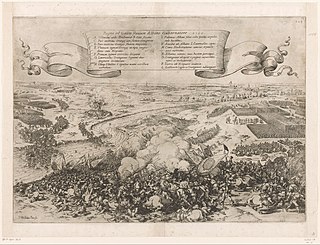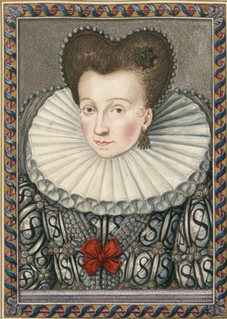
Henry IV, also known by the epithets Good King Henry or Henry the Great, was King of Navarre from 1572 and King of France from 1589 to 1610. He was the first monarch of France from the House of Bourbon, a cadet branch of the Capetian dynasty. He was assassinated in 1610 by François Ravaillac, a Catholic zealot, and was succeeded by his son Louis XIII.

Charles IX was King of France from 1560 until his death in 1574. He ascended the French throne upon the death of his brother Francis II in 1560, and as such was the penultimate monarch of the House of Valois.

Henry III was King of France from 1574 until his assassination in 1589, as well as King of Poland and Grand Duke of Lithuania from 1573 to 1575.

The French Wars of Religion is the term which is used in reference to a period of civil war between French Catholics and Protestants, commonly called Huguenots, which lasted from 1562 to 1598. According to estimates, between two and four million people died from violence, famine or diseases which were directly caused by the conflict; additionally, the conflict severely damaged the power of the French monarchy. The fighting ended in 1598 when Henry of Navarre, who had converted to Catholicism in 1593, was proclaimed Henry IV of France and issued the Edict of Nantes, which granted substantial rights and freedoms to the Huguenots. However, the Catholics continued to have a hostile opinion of Protestants in general and they also continued to have a hostile opinion of him as a person, and his assassination in 1610 triggered a fresh round of Huguenot rebellions in the 1620s.

The St. Bartholomew's Day massacre in 1572 was a targeted group of assassinations and a wave of Catholic mob violence, directed against the Huguenots during the French Wars of Religion. Traditionally believed to have been instigated by Queen Catherine de' Medici, the mother of King Charles IX, the massacre started a few days after the marriage on 18 August of the king's sister Margaret to the Protestant Henry of Navarre. Many of the wealthiest and most prominent Huguenots had gathered in largely Catholic Paris to attend the wedding.

François Hotman was a French Protestant lawyer and writer, associated with the legal humanists and with the monarchomaques, who struggled against absolute monarchy. His first name is often written 'Francis' in English. His surname is Latinized by himself as Hotomanus, by others as Hotomannus and Hottomannus. He has been called "one of the first modern revolutionaries".

Gaspard de Coligny, Seigneur de Châtillon, was a French nobleman, Admiral of France, and Huguenot leader during the French Wars of Religion. He served under kings Francis I and Henry II during the Italian Wars, attaining great prominence both due to his military skill and his relationship with his uncle, the king's favourite Anne de Montmorency. During the reign of Francis II he converted to Protestantism, becoming a leading noble advocate for the Reformation during the early reign of Charles IX.

Jean Bullant was a French architect and sculptor who built the tombs of Anne de Montmorency, Grand Connétable of France, Henri II, and Catherine de' Medici. He also worked on the Tuileries, the Louvre, and the Château d'Écouen. Bullant was a Huguenot.

François de la Noue, called Bras-de-Fer, was one of the Huguenot captains of the 16th century. He was born near Nantes in 1531, of an ancient Breton family.

The Battle of Jodoigne, also called Battle of the River Guete, was fought on 20 October 1568 between the royal Habsburg army led by the Duke of Alba and a protestant rebel army led by William of Orange. It resulted in a defeat for William of Orange, who had to abandon his plans of invading the Habsburg Netherlands.

The siege of La Rochelle of 1572–1573 was a massive military assault on the Huguenot city of La Rochelle by Catholic troops during the fourth phase of the French Wars of Religion, following the August 1572 St. Bartholomew's Day massacre. The conflict began in November 1572 when inhabitants of the city refused to receive Armand de Gontaut, baron de Biron, as royal governor. Beginning on 11 February 1573, the siege was led by the Duke of Anjou. Political considerations following the duke's election to the throne of Poland in May 1573 resulted in negotiations, culminating on 24 June 1573, that lifted the siege on 6 July 1573. The Edict of Boulogne signed shortly thereafter brought an end to this phase of the civil war.

The former French Catholic diocese of Noyon lay in the north-east of France, around Noyon. It was formed when Saint Medardus moved the seat of the bishopric at Vermandois to Noyon, in the sixth century. For four centuries it was united with the bishopric of Tournai. Then in the twelfth century it was again independent, and the bishop of Noyon became a pairie-comté of France.

Françoise d'Orléans was the second wife of Louis de Bourbon, Prince of Condé, a "Prince du Sang" and leader of the Huguenots during the French Wars of Religion.

François de Bourbon was the Duke of Montpensier and member of the House of Bourbon. He was the brother of Charlotte de Bourbon, Princess of Orange and wife of William the Silent, Prince of Orange. He was the great grandfather of La Grande Mademoiselle cousin of Louis XIV.

The siege of Mons of 1572 took place at Mons, capital of the County of Hainaut, Spanish Netherlands, between 23 June and 19 September 1572, as part of the Eighty Years' War, the Anglo-Spanish War (1585–1604), and the French Wars of Religion. In the spring of 1572, after the capture of Valenciennes by a Protestant force under Louis of Nassau, the Dutch commander continued with his offensive and took Mons by surprise on 24 May. After three months of siege, and the defeats of the armies of Jean de Hangest, seigneur d'Yvoy and Genlis, and William the Silent, Prince of Orange (Dutch: Willem van Oranje), by the Spanish army led by Don Fernando Álvarez de Toledo, Duke of Alba, Governor-General of the Spanish Netherlands, and his son, Don Fadrique de Toledo, Louis of Nassau's forces, isolated and without any hope of help, surrendered Mons to the Duke of Alba on 19 September.
Jean de Ferrières (1520–1586), Vidame de Chartres, Seigneur de Maligny, was an influential Huguenot in the French Wars of Religion in the 16th century. He died a prisoner in a galley, unable to pay his ransom, and was succeeded by his nephew, Pregent de La Fin.
The Battle of Le Quesnoy was fought between a mostly German army supporting the Dutch rebels and the Spanish Habsburg army.
François II de Hangest, Seigneur de Genlis, bailli & capitaine d'Évreux. was a French military commander, notable for his roles during the French Wars of Religion.
In historic texts, he is often named simply Genlis or Jenlis. Such texts often do not mention his death, in 1569, and continue to use the same name to mean his younger brother Jean de Hangest, seigneur d'Yvoy.













